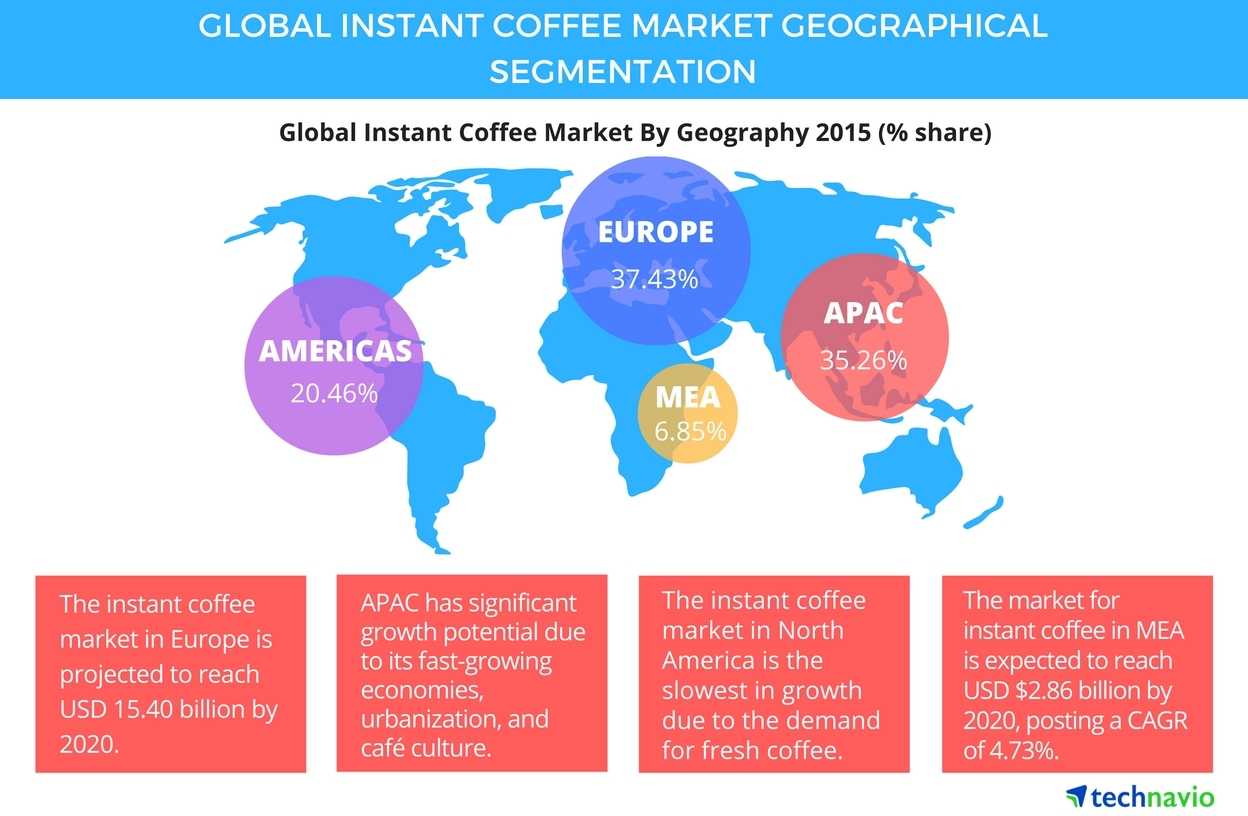LONDON, UK – The global instant coffee market is expected to grow at a CAGR of close to 6% by value, during the period 2016-2020, according to Technavio’s latest report.
In this report, Technavio covers the market outlook and growth prospects of the global instant coffee market for 2016-2020.
The market includes two types of coffee: spray-drying and freeze-drying. During the forecast period, the spray-drying instant coffee segment will continue to dominate the market due to its growing demand resulting from its powdered texture that can be quickly dissolved in hot water or milk.
“Cafés and coffee chains worldwide are increasing, which bodes well for the prospects of the global instant coffee market.
The competitors are establishing locations in busy markets and close to offices and colleges to cater to the increasing demand for coffee among students and the working populace,” says Brijesh Kumar Choubey, a lead non-alcoholic beverages research expert from Technavio.
Technavio’s food and beverage research analysts segment the global instant coffee market into the following regions:
- Europe
- APAC (Asia-Pacific)
- Americas
- MEA (Middle-East, Africa)
In 2015, with a market share of over 37%, Europe dominated the global instant coffee market, followed by APAC with over 35%, the Americas with over 20%, and MEA with close to 7%.
Europe: Russia is the largest market for instant coffee
Within Europe, eastern European countries are the key markets for instant coffee, compared to western European countries.
Among the eastern European countries, Russia is the prominent market for instant coffee. Coffee consumption in Russia is attributed to the economic growth that is heavily dependent on oil prices in Russia.
The demand for three-in-one coffee sachets increased considerably in Russia. These sachets combine coffee, whitener, and sugar and call for a preparation method like instant coffee.
Due to climatic conditions, coffee is not largely cultivated in this region.
Therefore, the region depends mainly on imports to meet the demand. The UK, Turkey, Belarus, and Ukraine are some other leading instant coffee-consuming countries in this region.
APAC: growing café culture to boost market growth
The instant coffee market in APAC is poised to grow during the forecast period, driven by the demand from China, Australia, Japan, and India. China is the key revenue contributor in the region, as it is exhibiting strong potential for the ready-to-drink segment.
Particularly, the demand for three-in-one coffee packets has soared in China. In countries such as Australia and New Zealand, instant coffee accounted for well over two-thirds of the retail brewed coffee consumed in 2015.
The younger population from emerging countries of the market is shifting from traditional drinks such as tea to instant coffee.
“APAC has witnessed significant growth potential due to many factors including its fast-growing economies, urbanization, and growing café culture, which have all contributed considerably to the market growth.
Many modern retail outlets are, thus, stocking large varieties of instant coffee, and new products are being launched by active competitors,” says Brijesh.
Americas: most countries in Latin America prefer instant coffee
In the Americas, Latin America is a key sourcing region for instant coffee. Brazil, Colombia, Costa Rica, El Salvador, Guatemala, Honduras, Nicaragua, Mexico, Panama, Peru, and Puerto Rico are the key exporters of instant coffee.
These coffee-producing countries are also large consumers of instant coffee, except for Brazil, which primarily consumes freshly brewed coffee. Other countries like Costa Rica and Colombia have exhibited a stable demand for instant coffee.
The instant coffee market in North America is slowest in growth owing to the demand for fresh coffee. Americans prefer freshly brewed coffee over instant coffee as they consider instant coffee to be inferior in taste, which is hindering the market growth.
MEA: surge in demand for instant coffee among youth in the Middle East
Traditionally, the demand for instant coffee was limited to the expatriate community in the Middle East, but this scenario has changed with time.
There is a surge in demand for instant coffee among youth in the Middle East.
As modern coffeehouses appear in the UAE, Bahrain, Kuwait, and Saudi Arabia, the demand for instant coffee is rising. In the Middle East, coffee is preferred over alcohol at social gatherings.
The Middle East is known for its traditional culture of male-dominated coffeehouses. However, in the next five years, a growth in female patrons is anticipated in the UAE, Turkey, and Bahrain, which will set a strong precedent and aid market growth throughout the region.
In Africa, the major producers of coffee are Ethiopia, Tanzania, Rwanda, Burundi, and Kenya.


















